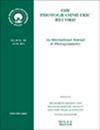利用超广角摄影进行地形测绘的调整实验
IF 3.6
3区 地球科学
Q2 GEOGRAPHY, PHYSICAL
引用次数: 3
摘要
本文介绍了利用三种不同的方法进行超广角摄影地形图控制的实验。结果表明,在Wild A9上观察到的独立模型的空中三角测量在制图工作量、控制要求和等高线精度方面具有经济优势。实验还表明,在适当的间隔内,在主照相罩上以直角飞行的扎带的增加对高程精度有很大的好处,而在要求接近间隔等高线的情况下,机载剖面记录仪提供的高度不够精确,在经济上是有利的。简历通信描述了三种不同的重要体验方法:三角测量法、摄影测量法、空间实用法、摄影超广角法。结果证明了方法的准确性、半类比性、半分析性、员工的效率、效率、价值、经济性、过程的恢复性、建立性、地形测量性,以及对方法精度的关注。L的经验demontre, L 'etablissement德·邦德:横向augmentent nettement精度des海拔等变量的傲慢记录par L的年费利率不是说精确倒唐纳联合国rendement摘要在中科院des courbes小区间。本文章由计算机程序翻译,如有差异,请以英文原文为准。
AN EXPERIMENT IN ADJUSTMENTS, USING SUPER‐WIDE ANGLE PHOTOGRAPHY TAKEN FOR TOPOGRAPHIC MAPPING
The paper describes an experiment using three different methods for the production of control for topographic mapping from super-wide angle photography. The result showed that aerial triangulation by independent models observed on a Wild A9 would show economic advantages in cartographic effort required, control requirements, and accuracy attained in contouring. The experiment also indicated that great benefit in heighting accuracy is derived from the addition of tie strips flown at right angles to the main photographic cover at a suitable interval and that heights supplied by airborne profile recorder are not sufficiently accurate to be economically advantageous where close interval contours are a requirement.
Resume
La communication decrit une experience comportant trois methodes differentes pour la triangulation photogrammetrique dans l' espace utilisant des photos super-grand-angulaire. Les resultats demontrent que la methode semi-analogique-semi-analytique employee avec l'appareil Wild A9 est la plus efficace du point de vue economique pour les procedes de restitution ansique pour l'etablissement du canevas topometrique, et aussi en ce qui concerne la precision des courbes. L' experience demontre que l'etablissement de bandes laterales augmentent nettement la precision des altitudes et que les hauteurs enregistrees par l' A.P.R. ne sont pas suffisamment precises pour donner un rendement economique dans le cas des courbes a petits intervalles.
求助全文
通过发布文献求助,成功后即可免费获取论文全文。
去求助
来源期刊

Photogrammetric Record
地学-成像科学与照相技术
CiteScore
3.60
自引率
25.00%
发文量
71
审稿时长
>12 weeks
期刊介绍:
The Photogrammetric Record is an international journal containing original, independently and rapidly refereed articles that reflect modern advancements in photogrammetry, 3D imaging, computer vision, and other related non-contact fields. All aspects of the measurement workflow are relevant, from sensor characterisation and modelling, data acquisition, processing algorithms and product generation, to novel applications. The journal provides a record of new research which will contribute both to the advancement of photogrammetric knowledge and to the application of techniques in novel ways. It also seeks to stimulate debate though correspondence, and carries reviews of recent literature from the wider geomatics discipline.
Relevant topics include, but are not restricted to:
- Photogrammetric sensor calibration and characterisation
- Laser scanning (lidar)
- Image and 3D sensor technology (e.g. range cameras, natural user interface systems)
- Photogrammetric aspects of image processing (e.g. radiometric methods, feature extraction, image matching and scene classification)
- Mobile mapping and unmanned vehicular systems (UVS; UAVs)
- Registration and orientation
- Data fusion and integration of 3D and 2D datasets
- Point cloud processing
- 3D modelling and reconstruction
- Algorithms and novel software
- Visualisation and virtual reality
- Terrain/object modelling and photogrammetric product generation
- Geometric sensor models
- Databases and structures for imaging and 3D modelling
- Standards and best practice for data acquisition and storage
- Change detection and monitoring, and sequence analysis
 求助内容:
求助内容: 应助结果提醒方式:
应助结果提醒方式:


